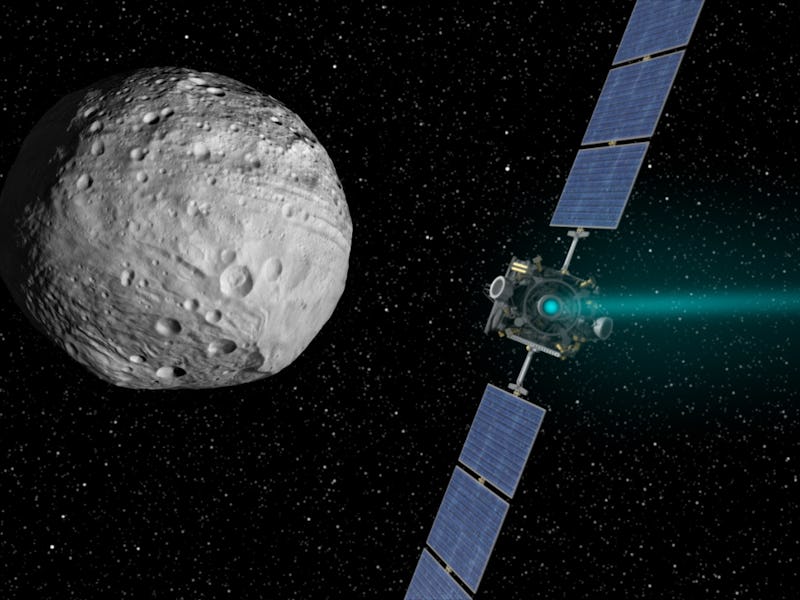In his 1952 short story, “The Martian Way,” science fiction legend Isaac Asimov imagined a future where settlers of the red planet, cut off from Earth’s water supply by an oppressive government, travel to the rings of Saturn to get their hands on precious ice.
As with any sci-fi written more than six decades ago, there are plenty of details we now know are inaccurate, and for a long time it looked like Asimov had erred when his settlers considered all their watery options. Vesta, the second-largest object in the asteroid belt between Mars and Jupiter, is described in the story as “a two-hundred-mile-diameter asteroid that’s hardly more than a chunk of ice,” very different from the arid space rock astronomers long took it to be.
Now, thanks to the latest round of results from NASA’s Dawn mission, we have learned Asimov was right about Vesta all along. As researchers at the University of Southern California write in Tuesday’s Nature Communications, the probe discovered unusually large smooth regions on the otherwise craggy asteroids. The researchers linked these with higher hydrogen concentrations, which in turn strongly suggest the presence of ground ice on Vesta.
“It was believed to be a dry body,” NASA researcher Essam Heggy, Ph.D. tells Inverse, saying previous evidence for water on Vesta had, at best, been ambiguous. Dawn’s findings erase those ambiguities. It’s just the latest of many findings in recent years showing that water and ice are damn near everywhere in the solar system, adding Vesta to a list that already includes Mars, the moons Europa and Enceladus, and its fellow asteroid Ceres.
“The more we search, the more we find ice and water in the solar system,” says Heggy, “and the more we realize water is not unique to our planet.”
The extent of Vesta's smooth, possibly hydrogen-rich areas
The presence of ice in the asteroid belt is especially intriguing, as collisions between asteroids can knock them out of their orbits and send them hurtling elsewhere in the solar system. Heggy says comets are already known to be a major transporter of water molecules through the solar systems. Asteroids might well have also played a role in distributing water, though he says it’s too early to speculate on what role they might have played in shaping Earth’s supply of water in the primordial solar system.
NASA’s Dawn spacecraft visited Vesta in 2011-12, and it has since moved on to Ceres. Even half a decade later, researchers are able to pull new observations from the Dawn data that would be impossible to replicate here on Earth.
“There are Earth-based radar observations of the asteroid system, but the Dawn spacecraft was able to explore the roughness on the surface of Vesta at much better resolution than we could do from the Earth,” says Heggy. “And that’s how we were able to distinguish the presence of large, smooth areas on the surface of Vesta.”
Beyond hinting at the presence of water on yet another body in the solar system, having this more precise understanding of Vesta’s surface means it’s even more possible for NASA to plan out a potential future landing on the asteroid. There might not be the same need for water that drove the explorers of “The Martian Way” to consider a trip to the icy asteroid, but this latest data suggests Vesta is very much worth seeing up close.
If you liked this article, check out this video on light pollution in space.
